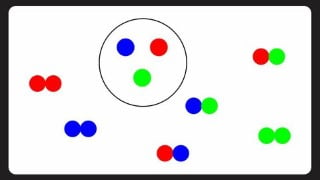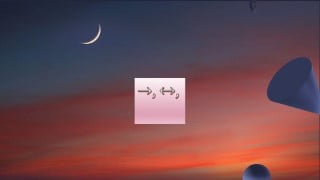Discrete Mathematics – Matrices & Determinants
Learn about matrices, their types, operations, and properties. Understand determinants, their properties, and applications. This course is suitable for engineering entrance exams, board exams, and competitive exams. Ideal for students worldwide.
What you’ll learn
- Introduction
- Matrix
- Order of a matrix
- Types of Matrices
- Operations on Matrices
- Transpose of a Matrix
- Symmetric and Skew Symmetric Matrices
- Invertible Matrices
- Determinant
- Properties of Determinants
- Area of a Triangle
- Minors and Cofactors
- Adjoint and Inverse of a Matrix
- Applications of Determinants and Matrices
Show moreShow less
Matrices
Concept, notation, order, equality, types of matrices, zero and identity matrix, transpose of a matrix, symmetric and skew symmetric matrices.
Operation on matrices: Addition and multiplication and multiplication with a scalar
Simple properties of addition, multiplication and scalar multiplication
Noncommutativity of multiplication of matrices and existence of non-zero matrices whose product is the zero matrix (restrict to square matrices of order 2)
Concept of elementary row and column operations
Invertible matrices and proof of the uniqueness of inverse, if it exists; (Here all matrices will have real entries).
Determinants
Determinant of a square matrix (up to 3 × 3 matrices), properties of determinants, minors, co-factors and applications of determinants in finding the area of a triangle
Ad joint and inverse of a square matrix
Consistency, inconsistency and number of solutions of system of linear equations by examples, solving system of linear equations in two or three variables (having unique solution) using inverse of a matrix
SUMMARY
Matrices
1. A matrix is an ordered rectangular array of numbers or functions.
2. A matrix having m rows and n columns is called a matrix of order m × n.
3. An m × n matrix is a square matrix if m = n.
4. A = [aij] = [bij] = B if (i) A and B are of same order, (ii) aij = bij for all possible values of i and j.
5. – A = (–1)A
6. A – B = A + (–1) B
7. A + B = B + A
8. (A + B) + C = A + (B + C), where A, B and C are of same order.
9. k(A + B) = kA + kB, where A and B are of same order, k is constant.
10. (k + l) A = kA + lA, where k and l are constant.
11. (i) A(BC) = (AB)C, (ii) A(B + C) = AB + AC, (iii) (A + B)C = AC + BC
12. A is a symmetric matrix if A′ = A.
13. A is a skew symmetric matrix if A′ = –A.
14. Any square matrix can be represented as the sum of a symmetric and a skew symmetric matrix.
15. If A and B are two square matrices such that AB = BA = I, then B is the inverse matrix of A and A is the inverse of B.
16. Inverse of a square matrix, if it exists, is unique.
Determinants
1. For any square matrix A, the |A| satisfy following properties.
2. |A′| = |A|, where A′ = transpose of A.
3. If we interchange any two rows (or columns), then sign of determinant changes.
4. If any two rows or any two columns are identical or proportional, then value of determinant is zero.
5. If we multiply each element of a row or a column of a determinant by constant k, then value of determinant is multiplied by k.
6. Multiplying a determinant by k means multiply elements of only one row (or one column) by k.
7. If elements of a row or a column in a determinant can be expressed as sum of two or more elements, then the given determinant can be expressed as sum of two or more determinants.
8. If to each element of a row or a column of a determinant the equimultiples of corresponding elements of other rows or columns are added, then value of determinant remains same.
9. Minor of an element aij of the determinant of matrix A is the determinant obtained by deleting i th row and j th column and denoted by Mij.
10. A (adj A) = (adj A) A = |A| I, where A is square matrix of order n.
11. A square matrix A is said to be singular or non-singular according as |A| = 0 or |A| ≠ 0.
12. If AB = BA = I, where B is square matrix, then B is called inverse of A.
13. A square matrix A has inverse if and only if A is non-singular.
14. Unique solution of equation AX = B is given by X = A–1 B, where A 0 ≠ .
15. A system of equation is consistent or inconsistent according as its solution exists or not.
16. For a square matrix A in matrix equation AX = B (i) |A| ≠ 0, there exists unique solution (ii) |A| = 0 and (adj A) B ≠ 0, then there exists no solution (iii) |A| = 0 and (adj A) B = 0, then system may or may not be consistent.
Who this course is for:
- Complete Mathematics for Engineering Entrance Exam Preparation. ( IIT-JEE Main | Advanced | BITSAT | SAT | etc.)
- Those preparing for board and competitive exams State Board, CBSE, ICSE , IGCSE, MHT-CET & NEET
- Courses are suitable for 160 countries from Europe, America, Middle East, Asia, Africa and APAC. Notably England, Germany, France, Sweden, Ireland, Scotland, USA, Canada, UAE, Saudi, Qatar, Kuwait, Malaysia, Indonesia, Myanmar, Newzealand, Australia, South Africa, South Korea, Nigeria, Nepal, Sri Lanka, etc
User Reviews
Be the first to review “Discrete Mathematics – Matrices & Determinants”
You must be logged in to post a review.







There are no reviews yet.